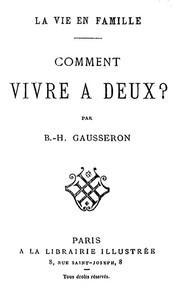|
|
Read this ebook for free! No credit card needed, absolutely nothing to pay.Words: 360460 in 77 pages
This is an ebook sharing website. You can read the uploaded ebooks for free here. No credit cards needed, nothing to pay. If you want to own a digital copy of the ebook, or want to read offline with your favorite ebook-reader, then you can choose to buy and download the ebook.

: A System of Practical Medicine. By American Authors. Vol. 1 Pathology and General Diseases by Pepper William Editor Starr Louis Editor - Medicine Practice@FreeBooksWed 07 Jun, 2023 sease was more fatal among those whose vaccinal scars were imperfect or few in number than among those who bore evidence that several pocks had been produced and had run a typical course. As to the influence of a perfect evolution of the lesion, but little doubt can be entertained, for we have already seen that in some instances its course is so different from what it should be that no protection whatever seems to result. When we come to consider the number of the pocks as affecting the degree or the duration of protection, however, an obvious source of fallacy arises in the fact that we cannot always be sure that some of the scars on a person having a number of them were not the products of a repetition of the operation several years after the first--that is to say, a revaccination, the efficiency of which in restoring lost immunity is now well established. Nevertheless, as long as the doubt remains the best course to pursue seems to be to act as if Marson's theory were in all respects correct, and vaccinate by multiple insertions. We have, then, no positive means of ascertaining who those persons are that are likely to fail of lasting protection, or how long a time will elapse before the cessation of their immunity will take place. The only safety lies in revaccination. But after how many years should revaccination be resorted to? It has been thought that this question might be settled by noting at what age, or at what period after primary vaccination, large numbers of people became susceptible of revaccination. This test, however, is not altogether trustworthy, for a renewed susceptibility to vaccinia by inoculation does not necessarily imply that the liability to take small-pox by effluvium has been regained. If it did, modified small-pox would be far more common than it is, for it is certain that revaccination can be made to succeed in a very large proportion of children long before they have reached the age of puberty. The fact is, contrary to the notions of the last generation, that success in revaccination is the rule, not the exception. Formerly it was not expected to succeed, and therefore no special pains were taken to ensure success. Definite rules cannot be laid down as to the time that should be suffered to elapse before vaccination is repeated, but in the great majority of instances safety may be attained by revaccination every five or six years, and always in the presence of an epidemic, regardless of the lapse of time; also whenever one's mode of life is to undergo a noteworthy change, as in emigrating to a foreign country, on entering the military service, and the like. To sum up, then, vaccination almost invariably protects against small-pox for the time being; generally for a long term of years; sometimes for a lifetime. Often the protection is absolute; as a rule, it is very nearly so; in rare instances it is trifling. In general terms, it may be said that it is scarcely less protective than variolous infection itself, for death from a second attack of small-pox is by no means rare. Here the question comes up: Is vaccination less protective, either in degree or in duration of effect, than it was at the time of its adoption? Given a typical vaccinia, we may unhesitatingly answer, No; but do we now so invariably produce the disease in all its essential features as was done in Jenner's time? Yes, provided we use proper virus and employ as much care as was taken by the older physicians, who, trained to the practice of variolation , did their work with a gusto now seldom witnessed. But there was a time, now happily at an end, when it was not easy to obtain thoroughly good virus, and when, therefore, the result was apt to vary materially from the standard. This may be conceded without entering upon the vexed question of the general deterioration of the Jennerian stock of vaccine. Besides immunity from small-pox, there are one or two sequelae of vaccinia that deserve mention before we proceed to consider what it is better to class as complications. In the first place, vaccination has been supposed to confer temporary protection against whooping cough. The writer is not aware, however, of any precise data going to prove either the truth or the falsity of this supposition. Secondly, by virtue probably of the inflammation that attends the evolution of the vaccinal pock, vaccination practised in the immediate neighborhood of a small naevus often cures that blemish, and it has been done for that purpose in many cases. It has no advantage over many other measures, however, and there is the disadvantage that the naevus may so mask the pock as to give rise to some doubt as to the satisfactory character of the latter. The practice, therefore, is not to be urged. COMPLICATIONS.--These are local and systemic. Those of them that are at all serious are rare, and can generally be traced to fortuitous circumstances. Inflammatory complications are usually due to undue traumatism at the time of the inoculation, to injury of the pock, or to the previous existence of a cutaneous disease or of some dyscrasia. Dermatitis is the most common. It is usually a mere erythema, but in some instances lymphangitis, lymphadenitis, phlegmonous inflammation, with diffuse suppuration, may result. From injury of the pock ulceration and gangrene may take place, and septic absorption may follow in their train. These complications are to be treated as if they had occurred from any other cause. Generally, the mere vaccination is not responsible for them, but in some instances putrescent vaccine may be adduced as their source. In such cases the complications, if they can still be called so, are apt to make their appearance long before the pock matures, even within forty-eight hours of the vaccination. Inflammatory complications supervening on the full development of the pock may invariably be set down as due to some cause not connected with the quality of the virus employed. An undue amount of dermatitis is best treated with some mildly astringent and anodyne application. The following liniment is excellent for the purpose: Rx. Unguenti Stramonii oz. j; Liquoris Plumbi Subacetatis fl. drachm ss; Olei Lini fl. oz. iv.--M. fiat linimentum. As a rule, it is best to avoid poultices applied over the pock itself, for they soften the tender structures that make up its dome and render it prone to rupture, with all the consequences that may follow its conversion into an open sore. When the latter accident has occurred, dusting powders will ordinarily suffice to absorb the discharge, and thus prevent putrefaction--either the ordinary toilet powder or salicylized or carbolized powders, the basis of which may be starch with a small proportion of the oxide of zinc. Besides the antiseptics mentioned, iodoform, boric acid, etc. may be used to advantage. Liquid applications are not usually so appropriate, but the writer has known the proprietary preparation termed Listerine to answer admirably. Circumscribed collections of pus are to be treated as under other circumstances, and burrowing is to be guarded against. It is only in the worst cases that constitutional treatment of any sort is demanded, and in these it should be of a supporting nature. At the present day we know that syphilis is liable to be communicated in vaccination, and that, too, without regard to visible blood in the lymph employed. There are two ways of avoiding it. One is, to use non-humanized lymph, since the lower animals are insusceptible to syphilis. This is simple. The other is, to select a human vaccinifer that is free from syphilis. This is difficult. Too great reliance, however, should not be placed upon the vaccinifer; it is possible to convey syphilis even in the use of bovine virus. Suppose two persons, A and B, are to be vaccinated at one sitting, A being syphilitic. If A is vaccinated first, and the same lancet, imperfectly cleansed, is used on B, it is plain that B will be inoculated not only with vaccine lymph, but also with A's blood. It is of the first importance, therefore, that this form of vaccinal inoculation of syphilis should be carefully guarded against; and that can be accomplished most certainly by using a fresh instrument for each patient. It is well, nevertheless, to take precautions against being placed on the defensive in this way; and it may commonly be avoided by declining to vaccinate infants under three or four months old, since inherited syphilis generally manifests itself by that time. This prudence on our own behalf should not be carried so far, however, as to lead us to deny the benefit of vaccination to very young infants whenever the prevalence of small-pox is such that they are in obvious danger of exposure. Free books android app tbrJar TBR JAR Read Free books online gutenberg More posts by @FreeBooks
: La Vie en Famille: Comment Vivre à Deux? by Gausseron Bernard Henri - Family life; Marriage FR Education et Enseignement@FreeBooksWed 07 Jun, 2023

: A Review of the Systems of Ethics Founded on the Theory of Evolution by Williams Cora May - Ethics Evolutionary@FreeBooksWed 07 Jun, 2023
|
Terms of Use Stock Market News! © gutenberg.org.in2025 All Rights reserved.






